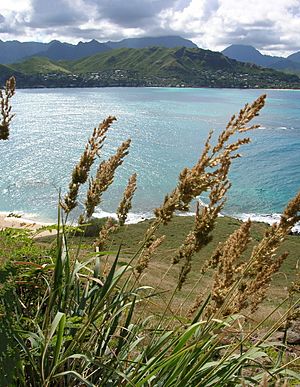Variable lovegrass facts for kids
Quick facts for kids Variable lovegrass |
|
|---|---|
 |
|
| Conservation status | |
| Scientific classification | |
| Genus: |
Eragrostis
|
| Species: |
variabilis
|
Eragrostis variabilis is a special type of grass that has a few different names. People call it variable lovegrass, kawelu, emoloa, and kalamalo. This grass is endemic to Hawaii. This means it grows naturally only in Hawaii and nowhere else in the world! You can find it on all the main Hawaiian islands. It also grows on some smaller, faraway islands like Kure Atoll and Midway Atoll.
Contents
About Variable Lovegrass
This grass is a perennial, meaning it lives for more than two years. It can look a bit different from one plant to another. That's why it's called "variable" lovegrass! Its smooth stems can stand tall, reaching over 3 feet high. The leaves and flower clusters (called panicles) can also vary in length. Some panicles are open and spread out. Others are dense and look like spikes. Plants from the main islands might look different from those on other Hawaiian islands. A single pound of its seeds can contain about 3,136,000 tiny seeds!
Where Variable Lovegrass Grows
This plant grows in many different island places. You can find it in dunes right by the ocean. It also grows on ridges and cliffs high up in the mountains. It can reach elevations of up to 3,700 feet. This grass likes areas that get a good amount of rain. It needs about 40 to 100 inches of rain each year to grow well.
Why This Grass is Important
Variable lovegrass is very important for many animals. On Laysan Island, this plant provides the main nesting spot for the rare Laysan finch (Telespiza cantans). These birds hide their nests safely inside clumps of the grass. It also offers important nesting cover for the rare Laysan duck (Anas laysanensis). Other bird species use this grass too. These include the brown noddy (Anous stolidus), wedge-tailed shearwater (Puffinus pacificus), and red-tailed tropicbird (Phaethon rubricauda).
How People Use Variable Lovegrass
Long ago, Native Hawaiians used this plant for thatching. Thatching is a way of making roofs for houses using plant materials. Today, people also use it as an ornamental grass. This means they grow it in gardens because it looks pretty.
Threats to Variable Lovegrass
Unfortunately, this important grass is being pushed out by an introduced weed. This weed is called sandbur (Cenchrus echinatus). When sandbur takes over, there is less space for variable lovegrass to grow. This means there is less nesting habitat available for the birds that depend on it.


